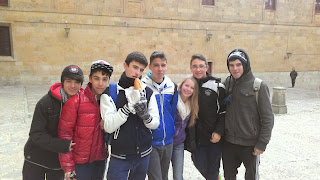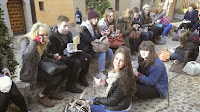To get you into the Christmas mood of 'Besinnlichkeit' (contemplation), here are some German Christmas carols..
Monday, 16 December 2013
Wednesday, 11 December 2013
German New Year's Eve Tradition: Bleigießen
Bleigießen (pronounced Bligh - geese -n) is a tradition popular in Germany and other Nordic countries to predict what the future holds for the New Year.
Silvester (New Year's Eve) is usually celebrated with friends at big parties or a dinner party with card games.
Popular meals for these occasions are those that can span several hours, often with a French origin, like fondue (where each person has a skewer to cook a piece of meat in a pot of broth on the table) or raclette (where you melt cheese over vegetables and breads in a special table top grill).
Just before midnight, you have to count down the seconds, of course, and after shouts of 'Frohes Neues Jahr!' (Happy New Year!), you do 'zuprosten' (raise and touch your glasses of champagne or sparkling wine and say Prost! (cheers). Then you go outside and watch the Feuerwerk (fireworks), or set them off yourselves. Hundreds of Raketen (rockets) light up the sky and loud 'Böller' (bangers/firecrackers) are supposed to chase away evil spirits.
For good luck, many Germans also eat a Krapfen or Berliner (jam filled dougnut) after midnight.
Also known as molybdomancy (if you like a fancy word for your next round of Scrabble!), it is the the technique of predicting the future from molten metal. The literal translation is 'lead pouring'.
People do this together at their Silvesterparty to see what the new year might bring!

In Germany, you can buy kits for this:
They contain small light figures made of lead (or zinc, which is less toxic), a spoon and a list of interpretations.
You melt one of the figures in the spoon over a candle, and then pour the liquid into a bowl of cold water. The resulting 'sculpture' then needs to be identified (you probably need quite bit of imagination for this!) and interpreted according to the list.
A pig or a frog, for example, could mean you might win the lottery, while a sword could mean 'problems in your job'.
The tradition of reading the future from molten metal goes back to Roman times, but these days it's just a bit of party fun and few people really believe in it.
Follow this link to see a video what it looks like:
http://www.youtube.com/watch?v=IEaiuKCh9wI
 As
the kits are hard to get in England (and lead can be dangerous if you
breathe in the fumes anyway) why don't you try the same thing with wax (ask your parent's permission and guidance if you're underage)
As
the kits are hard to get in England (and lead can be dangerous if you
breathe in the fumes anyway) why don't you try the same thing with wax (ask your parent's permission and guidance if you're underage)Get a candle, a bowl with water, and old spoon and some wax. Melt a small blob of wax in the spoon and then throw it in a bowl of cold water.
Use your fantasy to make out what the 'sculpture' is and make up what you think it means...
Here is a German website with interpretations for the different shapes: go on the letters at the top - and use an online dictionary...
http://www.bleigiessen.org/
Alternatively, if you have a smart phone there are even apps for Bleigiessen - check it out, but beware - you might have to pay!
Viel Spaß!
und einen guten Rutsch ins Neue Jahr!
(literally: have a good sliding into the new year...)
Tuesday, 26 November 2013
En el Instituto Galileo
We are spending our last full day in Spain at school. Tomlinscote students had the opportunity to attend a variety of lessons with their partners.
One group attended a Biology lesson in English as part of the bilingual section. All Tomlinscote students were very impressed with the level of English used during this difficult lesson on "stem cells".
Students will leave school at either 2pm or 3pm for their final afternoon in Spain. There is a farewell party organised by the Spanish students this evening.
¡Hasta pronto!
One group attended a Biology lesson in English as part of the bilingual section. All Tomlinscote students were very impressed with the level of English used during this difficult lesson on "stem cells".
Students will leave school at either 2pm or 3pm for their final afternoon in Spain. There is a farewell party organised by the Spanish students this evening.
¡Hasta pronto!
Monday, 25 November 2013
Another Birthday - Happy Birthday Josh!
We have another birthday being celebrated whilst away on the Spanish Exchange. Happy birthday to Josh for yesterday. He enjoyed a rendition or two of "Cumpleaños Feliz" in the main square of Salamanca.
Once back at school students went home with their partners ready for a full day at school tomorrow!
Once back at school students went home with their partners ready for a full day at school tomorrow!
La visita a Salamanca - Monday 25th November
At 9am on a VERY cold morning we all met up and set off on our trip to Salamanca. Our Spanish partners joined us today so were we a big group of 58! First stop was a trip on the tourist train. This train was most certainly not designed for 58 but somehow we managed to squeeze in and off we went round the city with the driver pointing out the most historical places.
After this refreshing trip we all visited the cathedral and climbed 100s of steps up to the bell tower.
Then we made our way to the Plaza Mayor so that the students could have some free time to shop and be together.
After this refreshing trip we all visited the cathedral and climbed 100s of steps up to the bell tower.
Then we made our way to the Plaza Mayor so that the students could have some free time to shop and be together.
Friday, 22 November 2013
La visita a Segovia - Friday 22nd November
Today we visited the beautiful city of Segovia with it´s amazing Roman aqueduct from the 1st century. As we approached the city our first view was of this impressive construction. After educatiing many of the students as to what an aqueduct actually is everyone agreed it was magnificent.
Next stop was the spectacular 16th Century "Catedral de nuestra señora de la Asunción y San Frutos.
As we approached "Plaza de Socorro" with rumbling tummies it was time for a "bocadillo" break in the sun!!
Once refuelled it was off to the magnificent Alcázar castle from the 11th - 14th Centuries. First we walked round the rooms admiring the paintings, furniture and suits of armour. This is where the Reyes Católicos lived in the Middle Ages. Walt Disney found inspiration for his castle from this impressive structure. Then it was time for our PE lesson! 152 spiralling stairs up to the top of Juan II tower. At the top we rested in the sun for the climb back down.
After some free time for shopping we had to warm up again (appearances can be deceptive and although it was sunny it was certainly not warm!!) and so we went for chocolate con churros.
Once back at school students met up with their partners and went home for a traditional Spanish weekend.
Next stop was the spectacular 16th Century "Catedral de nuestra señora de la Asunción y San Frutos.
As we approached "Plaza de Socorro" with rumbling tummies it was time for a "bocadillo" break in the sun!!
Once refuelled it was off to the magnificent Alcázar castle from the 11th - 14th Centuries. First we walked round the rooms admiring the paintings, furniture and suits of armour. This is where the Reyes Católicos lived in the Middle Ages. Walt Disney found inspiration for his castle from this impressive structure. Then it was time for our PE lesson! 152 spiralling stairs up to the top of Juan II tower. At the top we rested in the sun for the climb back down.
After some free time for shopping we had to warm up again (appearances can be deceptive and although it was sunny it was certainly not warm!!) and so we went for chocolate con churros.
Once back at school students met up with their partners and went home for a traditional Spanish weekend.
Subscribe to:
Comments (Atom)





















































